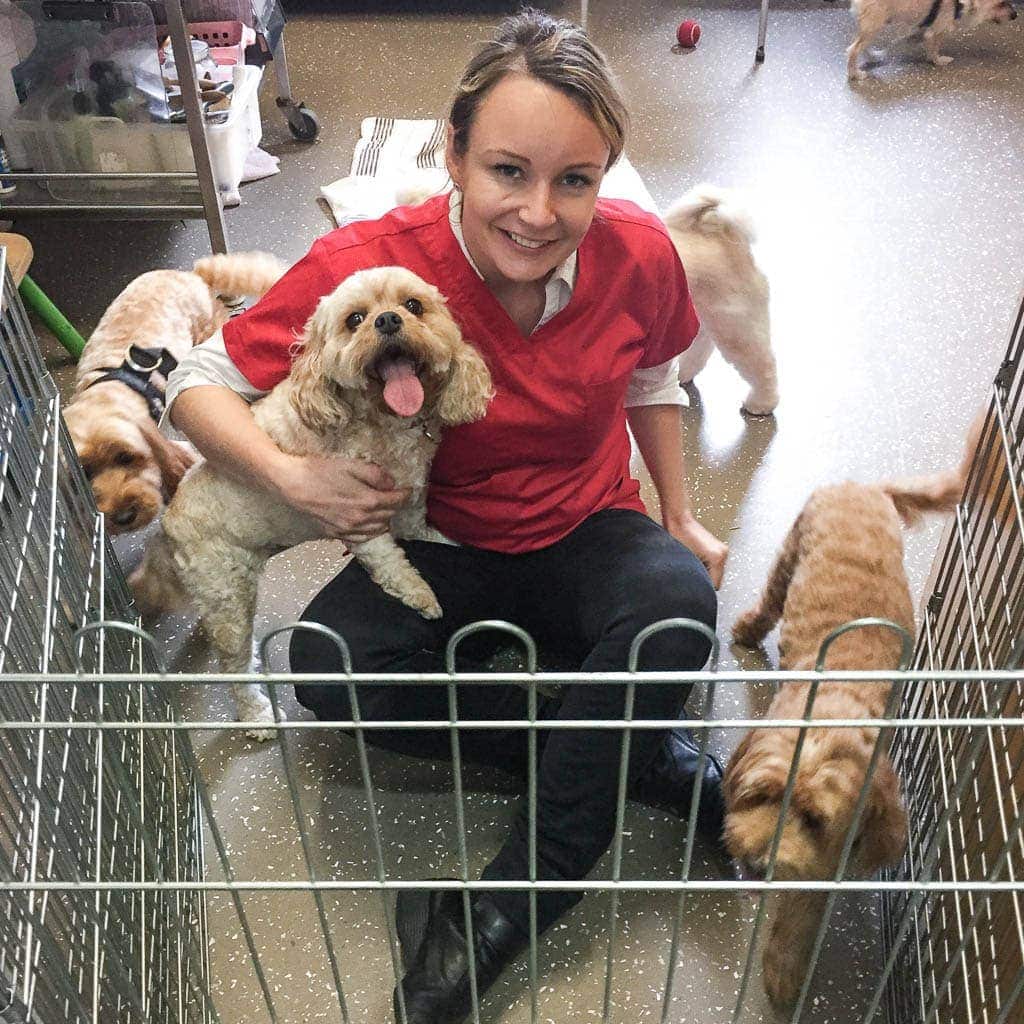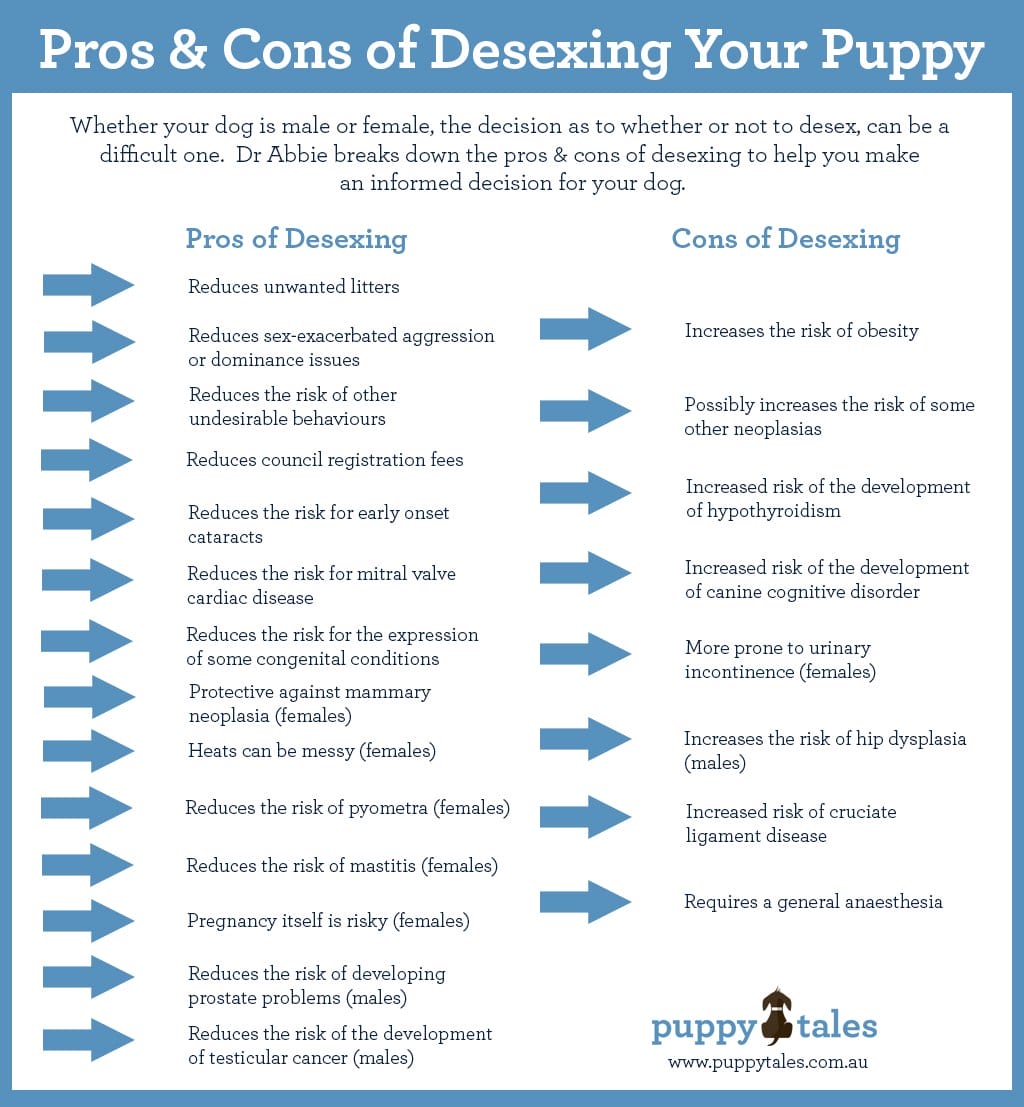Whether your dog is male or female, the decision as to whether or not to desex, can be a difficult one for some owners.
There is a lot of confusing information on the internet, and a lot of conflicting opinions, even amongst vets.
This post from Dr Abbie will give you a break down on the pros and cons of desexing, to help you make an informed decision for your dog.
 Save
Save
Before we continue, some useful definitions to know:
Neoplasia —> Cancer
Desexing —> Removing the ovaries +/- uterus in a female dog & testicles in a male dog to prevent reproduction
Intact/Entire —> A dog that has not been desexed
Spey —> Desexing a female dog
Castration —> Desexing a male dog
Pros to Desexing
- There is the obvious and important reason of reducing unwanted litters. Thousands of healthy dogs are euthanased in Australia and around the world every year. The number of homes available is finite, and there is a huge problem with over-supply of puppies. One way to look at it, is for every puppy that is born and takes one of those precious homes, another dog somewhere at a shelter or pound, is euthanased because a home cannot be found.
- Sex-exacerbated aggression or dominance issues, especially in male dogs, can make your pet more difficult to manage. Castration AFTER the behavioural problem has developed may not result in resolution of the problem. Prevention is certainly better than cure in this instance. Therefore, this can be an advantage of early desexing (desexing around 6 months of age). Desexing can also reduce the risk of your dog being attacked by another dog.
- Desexing reduces the risk of other undesirable behaviours such as inappropriate humping behaviour, territorial urine marking or barking, difficulty training because of reduced human focus and general difficulty restraining them from other dogs (their instinct will be to get near to other dogs to mate!). Behavioural issues are very important, as there are many instances of intact dogs escaping off the lead or out of a property, only to be hit by a car or sustain other injury.
- Desexing reduces council registration fees.
- Desexing reduces the risk for early onset cataracts.
- Desexing reduces the risk for mitral valve cardiac disease (a disease of the heart valves that reduces cardiac (heart) function.
- Desexing reduces the risk for the expression of some congenital conditions such as patent ductus arteriosus (leads to loss of cardiac function), ventricular septal defect (leads to loss of cardiac function) and porto-systemic shunt (where a vessel incorrectly bypasses the liver, leading to liver problems).
- In female dogs, early desexing has been shown to be protective against mammary neoplasia (cancer). Mammary neoplasia composes of around 50% of total canine neoplasia. Female dogs that are desexed before their first heat (around 6 months of age) have a 0.05% risk of developing a mammary neoplasm later in life. Between the first and second heats the risk increases to 8%, and between the second and third heat, the risk is 26%. Intact female dogs aged 2 years and over, have 7 times greater risk of developing mammary neoplasia when compared to dogs desexed at around 6 months.
- In female dogs, heats can be messy. Your bitch (female entire dog) may bleed for several days, which can stain furniture/carpet etc. You may also see behaviour changes such as restlessness, humping/mounting behaviour, aggression, excessive vocalisation or difficulty controlling around other dogs when your bitch is in heat. These symptoms are often undesirable to the pet owner. It can also be very difficult to adequately confine a bitch on heat. Entire males can smell a bitch on heat from a long way off and will go to great lengths to get to them (ie. your backyard may not necessarily be safe).
- Desexing in female dogs reduces the risk of pyometra, which is an infection of the uterus. 25% of entire female dogs will develop a pyometra. Often the only treatment is emergency spey. Emergency speys are not only a lot more expensive, but they are a lot more risky (you are operating on a very ill patient, not a young healthy patient). Pyometra is potentially a fatal condition and many dogs have died from this.
- Desexing in female dogs reduces the risk of mastitis, which may occur as a result of a ‘false pregnancy’ (ie. your bitch doesn’t need to have been mated). Mastitis can be a serious and painful condition.
- Pregnancy itself in females is risky. There can be complications such as problems delivering the puppies (sometimes also requiring emergency, risky, expensive surgery), hypocalcaemia, nutrition issues, mastitis etc.
- In male dogs, desexing significantly reduces the risk of them developing prostate problems such as enlarged prostate, prostatic cysts and prostatitis. It does not reduce the risk of prostate cancer, which is quite rare and holds a poor prognosis post diagnosis.
- In male dogs, desexing reduces the risk of the development of testicular cancer. Testicular cancer does have a reasonably high treatment success rate in most cases however castration is usually necessary.
- In male dogs, desexing reduces the risk of dilated cardiomyopathy, a disease where the heart becomes enlarged and floppy and reduces cardiac function.
- In male dogs, desexing reduces the risk of gastric dilation volvulus, commonly known as ‘twisted stomach’.
There is no increased risk of elbow dysplasia, lens luxation or patella luxation in desexed individuals.
 Save
Save
Cons to Desexing
- Desexing increases the risk of obesity. It is extremely important to reduce calorie intact post desexing, to ensure regular exercise and to keep a very close eye on your dog’s weight. Obesity can lead to a whole array of other health risks, so this is important.
- Desexing can possibly increase the risk of some neoplasias, for example bone tumors, Mast Cell Tumors and Haemangiosarcoma. However, these cases are overall less common than mammary neoplasia. Therefore, in female dogs, the proposed increased risk of some cancers, may not outweigh the reduced risk of mammary cancer. Also, the studies that have found an increased risk of these cancers, have been retrospective (looking at past data) therefore are considered to be less reliable. The other thing that is concerning about these studies, is that in general, owners of dogs that have followed veterinary advise to desex, are also more likely to follow recommendations in terms of diagnostic work ups. Therefore, is it that desexing leads to an increased risk of these cancers, or is it just that these cancers are more likely to be diagnosed in a desexed animal? There have been no prospective studies, so the evidence is slightly hazy.One other interesting piece of research is that females who are spey later (>12 months of age) are more prone to Mast Cell Tumors than those spey early (<12 month of age). However, intact females seem to have a lower incidence of mast cell tumors than both groups.
- There is an increased risk of the development of hypothyroidism. This is an endocrine disease that can lead to weight gain, hair loss, skin infections and lethargy. It is treatable with medications.
- There is an increased risk of the development of canine cognitive disorder in old age. This is essentially ‘doggie dementia’. It can cause confusion, inappropriate toileting, night waking and anxiety.
- There is an increased risk of epilepsy in desexed dogs.
- Female dogs that are desexed are more prone to urinary incontinence. This is the leaking of urine usually when they are sleeping or relaxed. It usually responds well to medications.
- Female dogs have an increased risk of intervertebral disc disease if desexed.
- Desexing leads to delayed closure of growth plates. In both sexes it leads to an increased risk of cruciate ligament disease. This could be a reason to delay desexing until the growth plates have fully closed. In large dogs this can be as late as 12-18 months.
- Desexing requires a general anaesthesia. However, it must be remembered that a general anaesthesia is often required for the treatment or diagnosis of mammary tumors, pyometra, prostatic problems, testicular cancer and other complications of not desexing. Therefore not desexing to avoid an anaesthetic isn’t necessarily wise, as the best time for a dog to be anesthetised is when they are young and healthy.
 Save
Save
Personal Opinion and Summary
Female Dogs
In my opinion, looking at the medical research, the benefits of desexing in relation to the reduced risk of mammary cancer, pyometra, mastitis, false pregnancy and complications if they should fall pregnant, greatly outweigh the increased risk of urinary incontinence, cruciate ligament disease, canine cognitive disease, hypothyroidism and possible risk of other cancers.
There are also the added benefits in female dogs of eliminating messy heats, reducing behavioural issues, reducing council fees and preventing unwanted litters.
Male Dogs
In my opinion, looking at the medical research, if you own a male dog, and the following items can be ticked:
- there are NO signs or even hints of the development of behavioural issues
- Your backyard is 100% secure
- You have excellent control of your dog both on and off the lead
then it could be beneficial to wait until your dog is fully grown (until around 12 months in small breeds and around 14 months in large breeds) before castrating. This will potentially reduce the risk of cruciate ligament disease, hip dysplasia and possibly some bone cancers.
Beyond this age, I think the benefits of castration, such as reduction in prostate problems, testicular cancer and behavioural issues outweigh the increased risk of canine cognitive disease, hypothyroidism and possible risk of other cancers.
There are also the added benefits of reducing behaviour issues, reducing council fees and preventing unwanted litters.
If you’ve decided that desexing is the best option for your dog, then you’ll want to continue reading Dr Abbie’s next post on the desexing procedure and pre & post operative care for your dog.